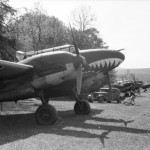
Wundshammer, Warschau, Sptember 1939
Benno Wundshammer, Warschau, Sptember 1939, Luftaufnahme eines Außenforts – Original-Bildunterschrift: “An der Ostfront. Eines der Außenforts der Festung Warschau nach der Bombardierung durch deutsche Kampfflugzeuge. 12051-39L
PK-Wundshammer – Scherl Bilderdienst”. Bundesarchiv Bild 183-S53297, Bild 183-S53297/Wikimedia Commons (CC BY-SA 3.0)
The current book project focuses upon the life, work and influence of Benno Wundshammer. Like thousands of other official German war photographers who took some 3.5 million photographs during World War Two. Wundshammer helped to shape the way the war was seen between 1939 and 1945 and thus also to affect the visual memory of World War Two up to the present day. After 1945, Wundshammer played an influential role in the development of West German illustrated newspapers and magazines. Before television became widespread in the 1960s, illustrated magazines were the most important medium shaping the visual universe in which West Germans lived. I want to see how Wundshammer and other members of this influential group of German photographers who took pictures for the Nazis but then subsequently worked for the most important post-war West German illustrated magazines dealt with the important propaganda work they had done for the Nazis and, more generally, with the moral and political implications of the practice of photography under dictatorship and, then, post-war democracy.
Wundshammer, Polen, September 1939
Benno Wundshammer, Polen, September 1939: Flüchtlinge (Propagandakompanien der Wehrmacht – Heer und Luftwaffe, Bild 101 I). Bundesarchiv Bild 101I-317-0015-34A/Wikimedia Commons (CC BY-SA 3.0)
This book is based on Benno Wundshammer’s unusual personal archive, now housed in the Bildarchiv Preußischer Kulturbesitz, Berlin. Unlike famous photographers who produced iconic images, photographers like Wundshammer usually disappear behind their cameras. We have their pictures, but we usually know very little about them. If photographers even bother to compile what could be described as an archive, this seldom includes much more than the photographs they have taken. Wundshammer’s archive is unusual. Wundshammer saved – one might even say obsessively hoarded – huge amounts of a wide range of different types of materials that are not normally found in a photographer’s private archive – not just contact sheets and prints of thousands of the photographs he had taken during the course of his long career but also personal correspondence, diaries, manuscripts of articles and books he had written, as well as copies of articles he had published.
In the summers of 2011, 2012, 2013, and 2014 I did extensive research in Wundshammer’s archive. I have now written rough drafts of five chapters of the projected book. I also presented a paper, “Learning War Photography: Benno Wundshammer’s relationship to his wartime photographs before and after 1945,” at a conference on “The Ethics of Seeing: German Documentary Photography Reconsidered” at the German Historical Institute-London from May 23-25, 2013. Wundshammer’s personal archive provides an unusual opportunity to reconstruct the everyday practices of a working photo-journalist in the Third Reich and the early Federal Republic and to see how this one “media worker” functioned within the larger landscape of wartime and post-war German illustrated magazines.
Wundshammer, Adenauer in Japan, März 1960
Benno Wundshammer, Japan, Besuch des Bundeskanzlers Konrad Adenauer, März 1960 (Presse- und Informationsamt der Bundesregierung – Bildbestand B 145 Bild). Bundesarchiv B 145 Bild-F008258-0021/Wikimedia Commons (CC BY-SA 3.0)